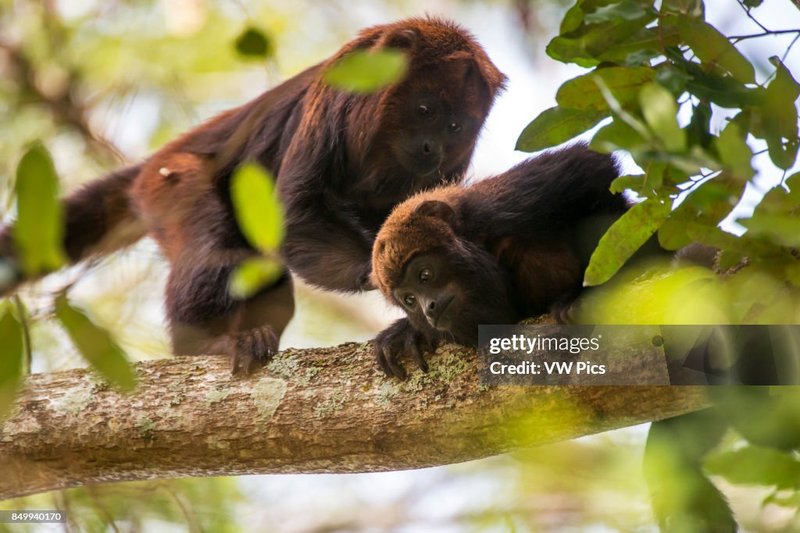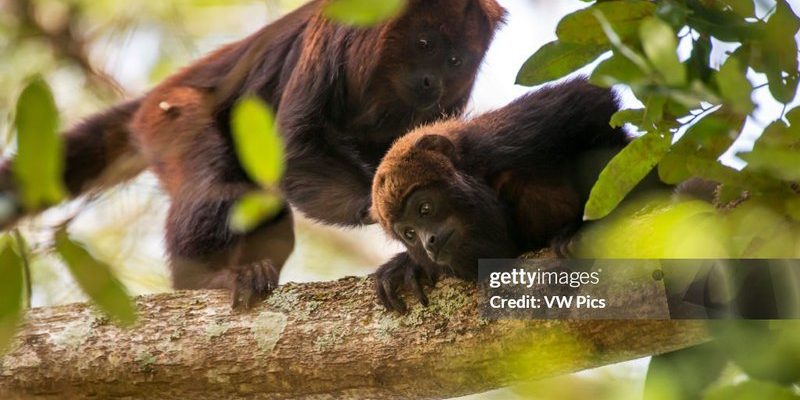
These fascinating creatures are more than just their signature howls. They play a vital role in their ecosystems while exhibiting some truly remarkable characteristics. Let’s dive into the top ten fascinating facts about the guariba, exploring their behavior, habitat, and role in the environment. Trust me, you’ll be captivated by these unique primates!
1. The Sound of the Jungle
One of the first things you’ll notice about howler monkeys is their distinctive vocalization. To put it simply, they are the loudest land animals on the planet. Their calls can be heard from miles away, reaching up to 3 miles in dense forests. This is quite handy when you’re in the thick of the jungle where sightlines are limited!
How do they produce such powerful sounds? Well, their enlarged throat sacs allow them to amplify their calls dramatically. Imagine blowing air into a balloon—it gets bigger because the air fills it up. The same principle applies here, giving these monkeys the ability to belt out tunes that can travel far and wide.
You might wonder why they make such a racket. Their howls serve as a way to establish territory and communicate with other groups. Think of it like a neighborhood watch call, alerting others to stay away while also keeping the group close.
2. Social Structure and Family Life
Guaribas are known for their strong social bonds. They typically live in groups of 6 to 15 individuals, consisting of a mix of males, females, and youngsters. These groups are often led by a dominant male, much like a king ruling over his kingdom!
Family dynamics in these groups can be quite fascinating. The males usually work together to defend their territory and keep the peace. Females, on the other hand, are responsible for most of the child-rearing. They nurture their young with care. Imagine a close-knit family where everyone takes part in raising the kids—it’s a heartwarming sight!
One interesting thing is the bond between mothers and their babies. Mother howler monkeys carry their young for several months, building a strong attachment that lasts into adulthood. This nurturing behavior is crucial for the survival of the babies, teaching them how to navigate their environment.
3. Habitat and Distribution
Howler monkeys are primarily found in tropical forests across Central and South America. Their range stretches from the southern U.S. down to Brazil. They inhabit various environments, including rainforest jungles, deciduous forests, and even swampy areas.
These monkeys are arboreal, which means they spend most of their time in trees. They rely on their long limbs and prehensile tails to swing gracefully from branch to branch. Picture yourself walking through a lush green forest; you might spot a group of howler monkeys perched high up, doing their thing in the treetops.
The loss of habitat due to deforestation poses a significant threat to their populations. As you can imagine, when trees are cut down, it disrupts their lives and makes it challenging for them to find food and shelter.
4. Diet: Herbal Gourmets
Guaribas are primarily herbivorous, meaning they crave fruits, leaves, seeds, and flowers. Their diet can include various plants, but they often have preferences for certain types. For instance, they enjoy eating leaves from fig trees and other fruit-bearing plants.
These monkeys are picky eaters, and their digestive systems are designed to break down tough plant material. Let’s consider their diet like a salad bar: they choose the tastiest, most nutritious options to fuel their active lifestyle.
Interestingly, howler monkeys have specialized bacteria in their guts that help them digest leaves, which can be quite tough to process. This is a fantastic example of how animals adapt to their diets, ensuring they can get the nutrients they need to thrive in their environments.
5. Unique Physical Features
Howler monkeys have some unique physical traits that make them stand out. Their most notable feature is their large throat sac, which not only helps them produce their loud howls but also plays a role in their social interactions.
In addition to their impressive vocal abilities, these monkeys have long, sturdy limbs for climbing and navigating their arboreal homes. Their tails are prehensile, meaning they can grip branches, much like a fifth limb. Just imagine how useful that would be when trying to balance while reaching for a snack!
Their fur is typically black or brown, with variations depending on the species. Some even sport a lighter shade, helping them blend seamlessly into their lush surroundings. This camouflage offers a layer of protection from predators, making it easier to hide when danger is near.
6. Sensitivity to Changes in the Environment
Howler monkeys are particularly sensitive to changes in their environment. They can be affected by climate changes, habitat loss, and even changes in food availability. It’s almost as if they have a built-in alarm system alerting them to shifts in their habitat.
Their keen sense of awareness helps them adapt, but they can struggle when faced with rapid changes. For example, if their primary food sources dwindle due to deforestation, they may have difficulty finding alternative options. This adaptability is impressive, yet it highlights the fragility of their existence.
Human activity plays a significant role in the changes they experience. By learning more about these monkeys and supporting conservation efforts, we can help ensure that they remain part of our world’s rich biodiversity.
7. Conservation Status
The conservation status of howler monkeys varies by species. Some populations are stable, while others face significant threats. Factors like habitat destruction, hunting, and the pet trade have had a negative impact on their numbers.
The IUCN Red List, a comprehensive resource for global conservation status, categorizes certain species of howler monkeys as endangered or vulnerable. Taken together, these factors paint a concerning picture of their future.
Conservation efforts are underway in many regions. This includes habitat restoration, legal protections, and education programs aimed at raising awareness. Community involvement is vital too, as local people often play a critical role in conservation success. It’s like teaming up to protect a treasure that benefits everyone.
8. Cultural Significance
Howler monkeys aren’t just fascinating creatures; they also hold cultural significance in many societies. Various indigenous peoples across Central and South America revere these monkeys and include them in their folklore and traditions.
In some cultures, howler monkeys symbolize communication and strength. You might find stories that highlight their calls as a way to connect with the spirit world, emphasizing their importance in local lore.
Their presence in literature, art, and even music further reflects their cultural influence. For those studying anthropology or simply curious about the connections between nature and society, understanding howler monkeys enriches our comprehension of human relationships with wildlife.
9. Lifespan and Reproduction
The lifespan of a howler monkey can be quite impressive, with some living up to 20 years or more in the wild. In captivity, they may live even longer, thanks to better medical care and nutrition.
In terms of reproduction, female howler monkeys typically give birth to one baby every two to three years after a gestation period of around 6 months. This relatively slow reproduction rate means that populations can take time to recover if they face significant threats.
The bond between mother and baby is strong. Youngsters will cling to their mothers for several months, learning essential survival skills and social behaviors. Watching a mother howler monkey care for her baby is a beautiful reminder of the nurturing instincts present in the animal kingdom.
10. Howler Monkeys as a Bioindicator
Believe it or not, howler monkeys play a crucial role as bioindicators, which means they help scientists monitor the health of their ecosystems. Because they are sensitive to environmental changes, their presence—or absence—can signal the overall well-being of their habitat.
When howler monkey populations decline, it can indicate problems such as habitat destruction or food shortages. By studying these monkeys, scientists can gain insights into the broader ecological health of the regions they inhabit. This can lead to better conservation strategies, helping to protect not just howler monkeys but also the myriad of species that share their ecosystems.
In a way, howler monkeys serve as a reminder of how interconnected we all are—our actions can ripple through the environment, impacting countless lives.
In conclusion, howler monkeys, or guaribas, are much more than just loud animals swinging through the trees. They are vital members of their ecosystems, cultural symbols, and indicators of environmental health. By understanding and supporting their conservation, we play a part in preserving these remarkable creatures and the biodiversity of the planet. So the next time you hear a howler’s echo in the distance, remember the story behind that powerful call.

